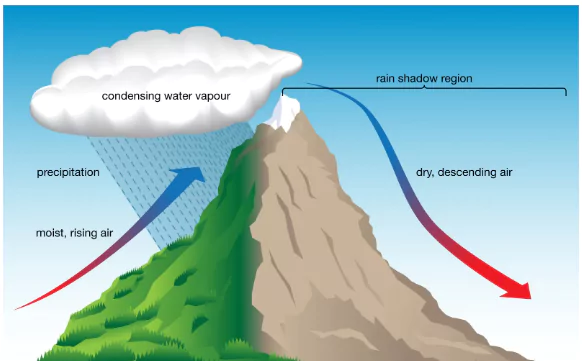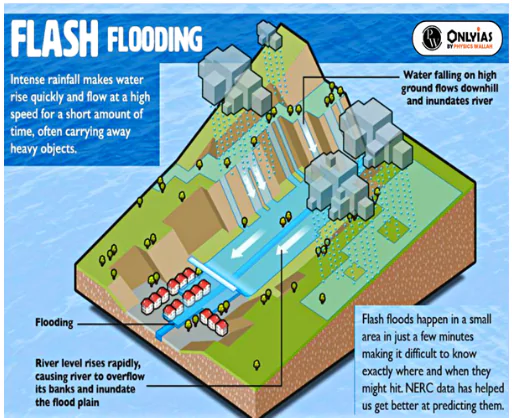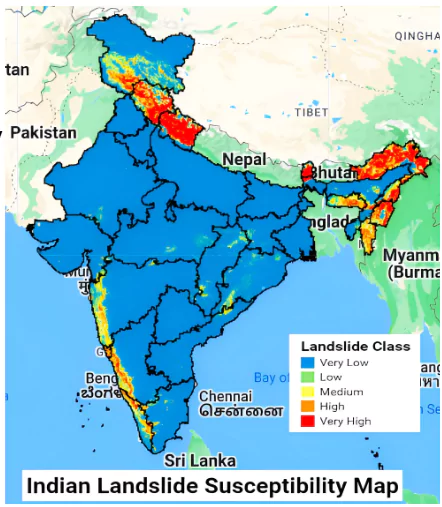Massive cloudbursts in the Ramban district of Jammu and Kashmir on April 20, 2025, caused heavy flash floods and landslides at multiple locations.
- The Ramban district administration posted information about the events using terms like flash flood, landslide, and cloudburst.
About Cloudburst

- A cloudburst is defined as “Rainfall of 10 cm or more in one hour over a roughly 10 km x 10 km area.”
- Example: A devastating cloudburst (record-breaking 944 mm of rain in just 24 hours) on July 26, 2005, caused catastrophic rainfall in Mumbai, paralyzing the city and leading to over 1,000 deaths.
- Mechanism: Common in hilly areas due to a process called orographic lift:
- Warm air rises along mountain slopes.
- It expands due to low pressure at altitude and cools.
- Cooling causes condensation and release of moisture.
- If warm moist air keeps rising, it may delay rainfall until a large volume suddenly condenses and falls as torrential rain.
- Occurence in India: In India, cloudbursts are frequently observed during the monsoon season, particularly over regions like the Himalayas, the Western Ghats, and the northeastern hill states.
- Linkage with Flash floods: Cloudbursts often result in flash floods and have become increasingly common from May-September when the southwest monsoon season prevails in much of the country.
- Impacts:
- Sudden, localized heavy rain.
- Often leads to flash floods and landslides due to drainage overload and rapid water accumulation.
- Difficult to detect due to the small area and short time frame.
Flash Floods

- According to the India Meteorological Department (IMD), a flash flood is a sudden, rapid flooding event that typically occurs within a short period, generally less than 6 hours, due to intense rainfall, often associated with cloudbursts or heavy thunderstorms.
Causes of Flash Flood
- Exceeds Dam Capacity: Flash floods can be caused by factors other than rainfall. For example, when water exceeds the capacity of a dam, it can lead to flash floods.
- The release of water from the Chungthang dam, Sikkim led to a sudden increase in water levels up to 15-20 feet high in the Teesta River, causing Flash floods downstream.
- Cloud Bursts: In India, flash floods are often associated with cloud bursts, which are sudden, intense rainfall events that occur within a short duration.
-
- At least 13 were killed as flash floods hit Amarnath Yatra camp (in July 2022)
- Melting Glaciers: Himalayan states face the challenge of overflowing glacial lakes, formed due to the melting of glaciers.
- Cloud burst and GLOF in Kedarnath in 2013
- Landslide: Flash floods are accompanied by landslides, which are sudden movements of rock, boulders, earth or debris down a slope.
- In February 2021, flash floods killed nearly 200 people and washed away houses in Uttarakhand.
- Urbanization and Poor Drainage Systems: Urban areas with extensive concrete surfaces and inadequate drainage systems are prone to flash floods. Impervious surfaces prevent water from infiltrating the ground, resulting in rapid runoff and increased flood risk.
- Recent example of New Delhi Floods (2023).
- Deforestation and Soil Erosion: Removal of vegetation, such as forests or grasslands, can disrupt the natural water absorption capacity of the soil.
- Climate Change: Climate change is caused by human activities, resulting in erratic weather patterns and extreme weather events like hurricanes, etc., increasing flash floods.
Landslides
- As per NDMA, “Landslides are the downward and outward movement of slope-forming materials like rock, debris, and earth under the influence of gravity.”
- Factor: When the pull from gravity exceeds the strength of the geomaterial forming the slope of a hill or mountain.

Reason for Landslides
- Due to Natural Factors: Occurs mainly in mountainous terrains where there are conducive conditions of soil, rock, geology and slope.
- Natural causes that trigger it include heavy rainfall, earthquakes, snow melting and undercutting of slopes due to flooding.
- Due to the Anthropogenic activities: Such as excavation, cutting of hills and trees, excessive infrastructure development, and overgrazing by cattle
- Excess Load: The risk from landslides has been exacerbated by the failure to remain mindful of the terrain’s ability to withstand the load.
- Lack of Regulations: Many hilly areas do not have building regulations. Often, regulations are not implemented effectively.
- Construction and Development: New constructions, infrastructure development, and even agricultural practices can increase the risk of landslides.
- Exceeding Carrying Capacity: Every mountainous area has a carrying capacity.
- Development is essential, and one cannot stop the creation of infrastructure or new facilities or economic activity for local populations. But these have to be regulated.
- Sustainability has to be factored in, so that the load does not exceed the carrying capacity.
Landslide Concerns & Vulnerability
- India is among the top five landslide-prone countries globally, where at least one death per 100 sq km is reported in a year due to a landslide event.
- According to the Geological Survey of India (GSI), about 0.42 million square km of India’s landmass, or about 13% of its area, spread over 15 states and four Union Territories, is prone to landslides,
- This covers almost all the hilly regions in the country.
- North Eastern States: About 0.18 million square km, or 42% of this vulnerable area is in the Northeastern region, where the terrain is mostly hilly.
- Between 2015 and 2022, the eight states in this region, including Sikkim, recorded 378 major landslide events which resulted in loss of life or damage to property.
- These events constituted 10% of all major landslides in India during this period.
- In the country as a whole, Kerala saw the largest number of landslides 2,239 most of which occurred after the disastrous 2018 floods in the state.
About Extreme Weather Events
- Definition: When the weather conditions show significant differences than the usual weather, this is termed as extreme weather or severe weather.
- The extreme weather conditions may last for a while or sometimes it may take just one or two days to become normal.
|

Reasons for Extreme Weather Conditions in India
- Climate Change & Global Warming: Rising temperatures intensify heatwaves, cyclones, and erratic rainfall.
- Increased frequency of cyclones (e.g., Cyclone Biparjoy 2023 intensified due to warmer Arabian Sea).
- Orographic Effects in Hilly Regions: In mountainous areas, warm moist air is forced to rise, cools rapidly, and releases moisture, sometimes causing cloudbursts and intense localized rainfall.
- The April 2025 Ramban incident involved orographic rainfall that led to cloudbursts, flash floods, and landslides.
- Deforestation and Unregulated Urban Expansion: Cutting down forests and expanding cities without planning reduces natural drainage and increases surface runoff.
- The Ramban disaster saw severe damage due to unplanned constructions and blocked traditional stormwater drains, aggravating flash floods and landslides.
- Weak Geology and Infrastructure Projects in Fragile Zones: Mountain regions with loose geological formations become more vulnerable when subjected to construction and drilling.
- The NDMA guidelines classify Himalayan slopes as geodynamically active and highly prone to landslides. In Ramban, ongoing 4-lane highway tunneling weakened already unstable mountains.
- Cloudbursts Leading to Flash Floods: Sudden, high-intensity rain overwhelms natural and artificial drainage, leading to devastating floods.
- Regions like Gurez and Tangdhar in Jammu & Kashmir frequently experience flash floods due to narrow valleys and intense rainfall.
- Extreme Weather Linked to Western Disturbances: Western disturbances bring sudden rain, hail, or snowfall, especially over J&K, Himachal, and Uttarakhand.
- Avalanches and blizzards in areas like Banihal, Gulmarg, and Kishtwar often follow such disturbances.
- Flash Floods Due to Rocky Terrain and Poor Absorption: In hilly areas, the rocky soil doesn’t absorb rain quickly, leading to sudden runoff and floods.
- Flash floods carry high debris loads — mud, rocks, vehicles, and even buildings.
- Climate Sensitivity of Jammu & Kashmir: J&K is a multi-hazard prone region due to its topography and changing climate.
- NDMA notes that 15% of India’s area is landslide-prone, especially Himalayan states.
- El Niño & La Niña: The 2023 El Niño event in East India did indeed cause droughts, and the La Niña of 2022 in Assam/Bengal led to heavy rainfall and flooding
Way forwards
- Institutionalize Early Warning Systems: Implement real-time monitoring systems and strengthen forecasting capacity, especially in hilly terrains.
- Real-time landslide monitoring and warning systems are crucial for issuing alerts based on minor slope changes and enabling timely evacuation.
- Integrate Hazard Zonation in Planning: Make Landslide Hazard Zonation (LHZ) and Seismic Hazard Zonation mandatory in all construction and land-use planning.
- Prioritization of LHZ mapping is essential to restrict development in vulnerable zones.
- Regulate Unplanned Urban Expansion: Enforce strict urban planning norms in hill towns and prevent construction near natural water channels.
- Unregulated expansion, blocked stormwater drains, and lack of expert planning, worsens the impact of rainfall.
- Enforce Environmentally-Sensitive Infrastructure Projects: Require geological, hydrological, and environmental clearance for all major infrastructure in fragile areas.
- Continuous tunneling and road-cutting activities can destabilize fragile formations and must be regulated.
- Promote Slope Stabilization and Drainage Management: Implement slope protection works, debris clearance, and proper drainage systems to reduce slope failure.
- Control works, restraint works, and proper drainage are critical for reducing landslide risk.
- Build Local Community Preparedness and Response: Train and involve local populations in disaster warning recognition, safe evacuation, and relief management.
- Community participation is listed as a core pillar in early warning systems and effective disaster response.
- Establish Institutional Mechanisms and Dedicated Research Centers: Set up state-level disaster management institutions and a Centre for Landslide Research, Studies, and Management, as proposed in the guidelines.
- Establishing a central body to manage landslide data, research, and training.
Conclusion
The Ramban disaster underscores the urgent need for robust disaster management in India’s vulnerable hilly regions. Integrating early warning systems, regulating unplanned development, and prioritizing environmental sustainability can mitigate the devastating impacts of cloudbursts, flash floods, and landslides.
![]() 21 Apr 2025
21 Apr 2025





